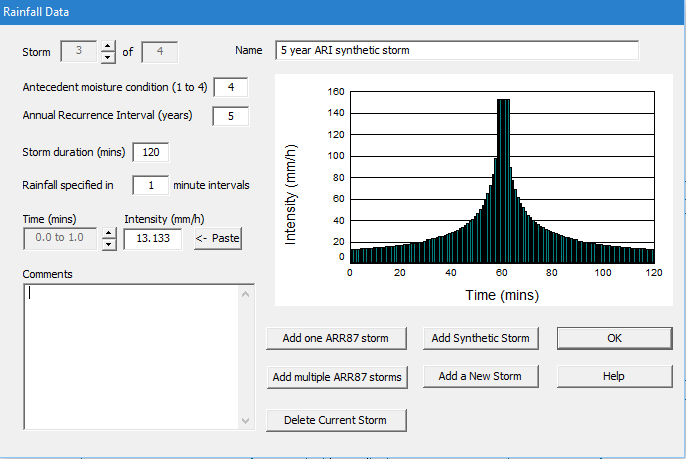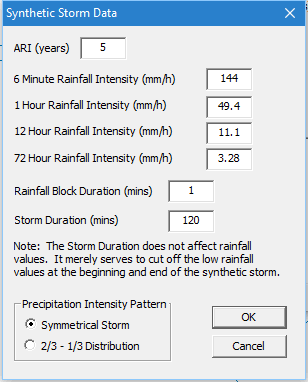Synthetic storms for the Extended Rational Method
The extended rational method (ERM) can be applied using the design storm patterns from Australian Rainfall and Runoff 1987 used by the Horton (ILSAX) and storage routing hydrological models or using synthetic patterns derived from the local intensity-frequency-duration (I-F-D) relationships. The latter will give the same peak rainfall values as the rational method because they are derived directly from the I-F-D data.
Synthetic storms should not be applied with the Horton (ILSAX) or storage routing hydrological models.
An example of synthetic storms is shown below. They include a number of nested storms, with the average intensity for any duration equaling the intensity specified by the I-F-D relationship for that duration. Known as the Chicago storm patterns, these relationships have been used in the United States for some time and are also applied in the UK and Hong Kong.

These can be generated using a facility in the Rainfall Data property sheet that is available when DRAINS licensed to run rational method models. In this case, the Add Synthetic Storm button shown above appears. Clicking on this button opens the following dialog box, which is used to set up the pattern shown above.

An example of synthetic storms is shown below. They include a number of nested storms, with the average intensity for any duration equaling the intensity specified by the I-F-D relationship for that duration. Known as the Chicago storm patterns, these relationships have been used in the United States for some time and are also applied in the UK and Hong Kong.
These can be generated using a facility in the Rainfall Data property sheet that is available when DRAINS licensed to run rational method models. In this case, the Add Synthetic Storm button shown above appears. Clicking on this button opens the following dialog box, which is used to set up the pattern shown above.
The four intensities must be obtained from the local I-F-D data. The block duration affects the intensities derived. A 1 minute block duration should normally be specified. This will provide an exact match to the average intensity obtained from the I-F-D data for any whole number duration (e.g. 5, 6, 7, 8, etc, minutes). This will ensure automatic calibration of peak flows from sub-catchments against the standard rational method procedure. The storm duration selected should be considerably longer than the time of concentration of the catchment. The volume of the hydrograph will increase for longer storm durations.
The 2/3 - 1/3 option pushes the peak of the rainfall pattern to the right so that its peak occurs at two-thirds of the specified storm duration. Further information on this can be obtained in the San Diego County Hydrological Manual available on the internet. This is claimed to be more conservative for detention basin design.
Related Articles
Extended rational method (ERM)
A hydrological model that produces hydrographs, such as the Horton (ILSAX), RORB, RAFTS and WBNM models, must be applied to analyse the storage routing effects of detention basins. The rational method is not suitable because it only calculates peak ...Rational Method
Developed in the 19th century, the rational method is the most widely-used hydrological procedure for estimation of design flowrates. It employs the equation: Q = C.I.A / F where Q is a peak flowrate in m3/s or L/s, C is a dimensionless runoff ...Major/Minor design for a street drainage system at Gymea, NSW, using the extended rational method
The file for this example is Gymea Rational & ERM ARR 2019 Example - Lite.drn, located in the folder C:\ProgramData\Drains among the Lite examples. If this folder is hidden, in File Explorer select the View tab and tick the Show Hidden Items box to ...Rational method Check HGL outputs
Detailed results from rational method calculations can be obtained in tables suitable for checking using the Copy Check HGL to Spreadsheet option in the Edit menu. Currently a 56-column output is provided, illustrated by the example shown below. ...Rainfall data for Rational Method property sheet
This window is used to enter ten values that define the key average recurrence intervals (ARIs) and rainfall intensities required to define the intensity-frequency-duration relationships to be used in rational method calculations. The ARIs entered ...